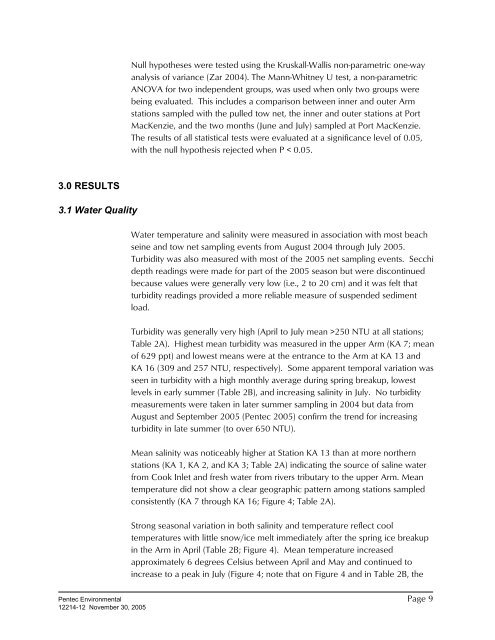Marine Fish and Benthos Studies - Knik Arm Bridge and Toll Authority
Marine Fish and Benthos Studies - Knik Arm Bridge and Toll Authority
Marine Fish and Benthos Studies - Knik Arm Bridge and Toll Authority
You also want an ePaper? Increase the reach of your titles
YUMPU automatically turns print PDFs into web optimized ePapers that Google loves.
Null hypotheses were tested using the Kruskall-Wallis non-parametric one-way<br />
analysis of variance (Zar 2004). The Mann-Whitney U test, a non-parametric<br />
ANOVA for two independent groups, was used when only two groups were<br />
being evaluated. This includes a comparison between inner <strong>and</strong> outer <strong>Arm</strong><br />
stations sampled with the pulled tow net, the inner <strong>and</strong> outer stations at Port<br />
MacKenzie, <strong>and</strong> the two months (June <strong>and</strong> July) sampled at Port MacKenzie.<br />
The results of all statistical tests were evaluated at a significance level of 0.05,<br />
with the null hypothesis rejected when P < 0.05.<br />
3.0 RESULTS<br />
3.1 Water Quality<br />
Water temperature <strong>and</strong> salinity were measured in association with most beach<br />
seine <strong>and</strong> tow net sampling events from August 2004 through July 2005.<br />
Turbidity was also measured with most of the 2005 net sampling events. Secchi<br />
depth readings were made for part of the 2005 season but were discontinued<br />
because values were generally very low (i.e., 2 to 20 cm) <strong>and</strong> it was felt that<br />
turbidity readings provided a more reliable measure of suspended sediment<br />
load.<br />
Turbidity was generally very high (April to July mean >250 NTU at all stations;<br />
Table 2A). Highest mean turbidity was measured in the upper <strong>Arm</strong> (KA 7; mean<br />
of 629 ppt) <strong>and</strong> lowest means were at the entrance to the <strong>Arm</strong> at KA 13 <strong>and</strong><br />
KA 16 (309 <strong>and</strong> 257 NTU, respectively). Some apparent temporal variation was<br />
seen in turbidity with a high monthly average during spring breakup, lowest<br />
levels in early summer (Table 2B), <strong>and</strong> increasing salinity in July. No turbidity<br />
measurements were taken in later summer sampling in 2004 but data from<br />
August <strong>and</strong> September 2005 (Pentec 2005) confirm the trend for increasing<br />
turbidity in late summer (to over 650 NTU).<br />
Mean salinity was noticeably higher at Station KA 13 than at more northern<br />
stations (KA 1, KA 2, <strong>and</strong> KA 3; Table 2A) indicating the source of saline water<br />
from Cook Inlet <strong>and</strong> fresh water from rivers tributary to the upper <strong>Arm</strong>. Mean<br />
temperature did not show a clear geographic pattern among stations sampled<br />
consistently (KA 7 through KA 16; Figure 4; Table 2A).<br />
Strong seasonal variation in both salinity <strong>and</strong> temperature reflect cool<br />
temperatures with little snow/ice melt immediately after the spring ice breakup<br />
in the <strong>Arm</strong> in April (Table 2B; Figure 4). Mean temperature increased<br />
approximately 6 degrees Celsius between April <strong>and</strong> May <strong>and</strong> continued to<br />
increase to a peak in July (Figure 4; note that on Figure 4 <strong>and</strong> in Table 2B, the<br />
Pentec Environmental Page 9<br />
12214-12 November 30, 2005
















